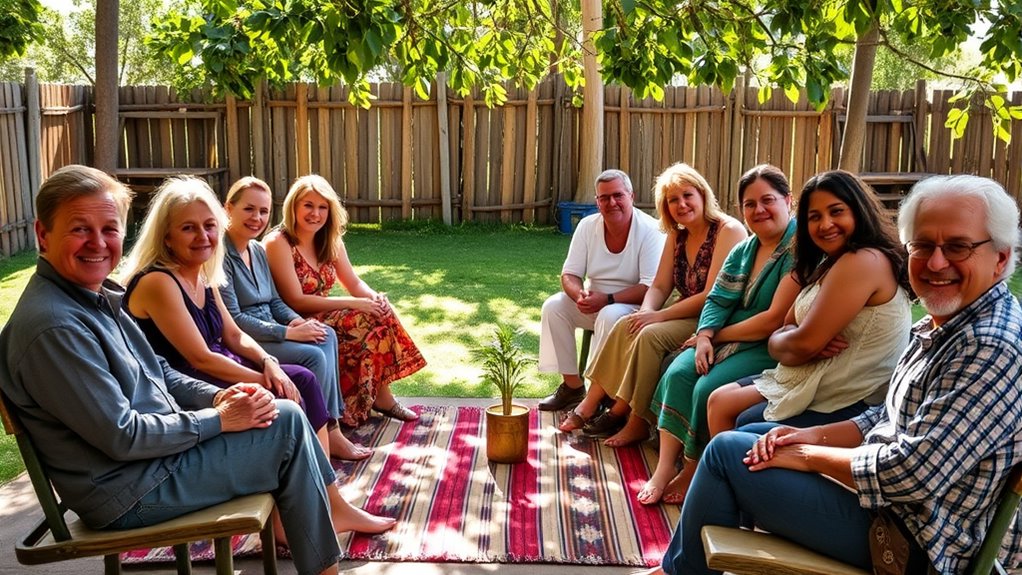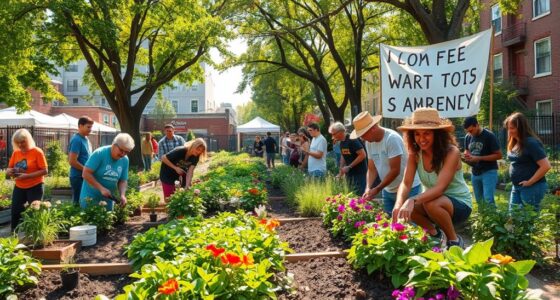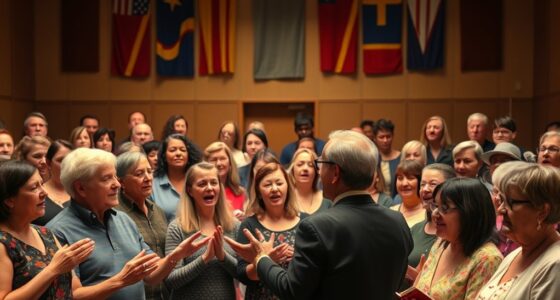To facilitate a community circle for mutual support, start by clearly setting intentions and creating ground rules that promote respect, confidentiality, and active listening. Foster a safe and inclusive environment where diverse perspectives are valued and everyone feels comfortable sharing. Guide the conversation with open-ended questions, reflect emotions, and summarize key points. Encourage balanced participation and close the circle with reflections or gratitude. Exploring these steps further can help you build a truly supportive and connected space.
Key Takeaways
- Clearly communicate the purpose, ground rules, and confidentiality to foster trust and openness.
- Create a safe, inclusive environment by respecting diverse backgrounds and modeling vulnerability.
- Use open-ended questions and active listening to guide meaningful conversations and validate emotions.
- Encourage equal participation by inviting quieter members and balancing input from all participants.
- Conclude with reflection, gratitude, and a moment of silence to reinforce connection and shared support.
Setting Intentions and Ground Rules
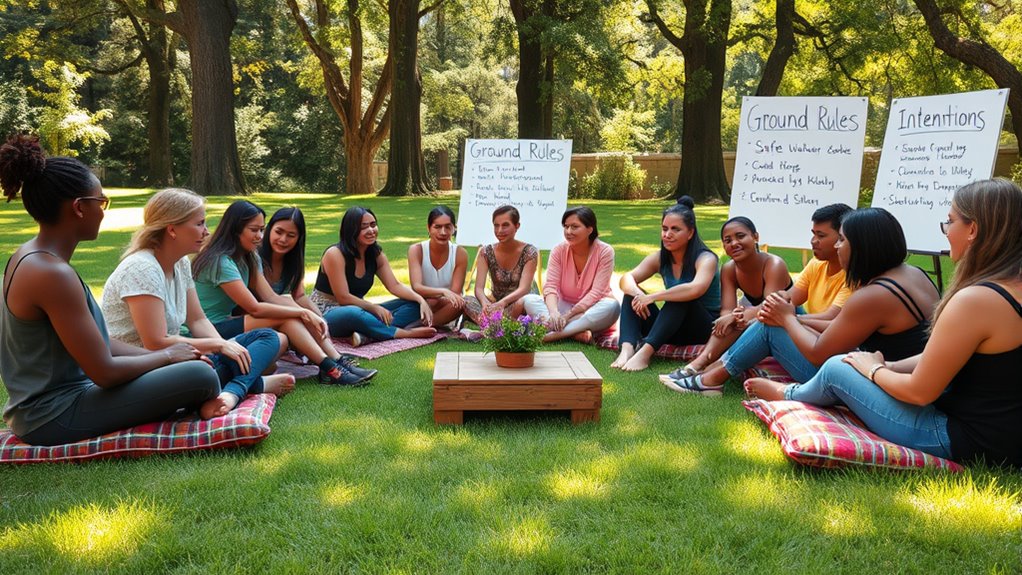
Before starting a community circle, it’s essential to set clear intentions and establish ground rules. This step helps build trust and ensures everyone understands the purpose of the circle. When you clearly communicate your intentions, participants feel more connected and open to sharing. Establish ground rules that promote respect, active listening, and confidentiality. These rules serve as a foundation for trust building, making participants feel safe and valued. Having clear guidelines also facilitates conflict resolution by providing a shared framework for addressing disagreements calmly and constructively. When everyone understands and agrees on the ground rules, it creates a positive environment where open dialogue can thrive. Incorporating best practices for group facilitation can further enhance the effectiveness of your community circle. Creating an environment that encourages trust and safety is vital for meaningful participation. Understanding the importance of confidentiality from the start can strengthen trust among participants. Additionally, integrating sound healing science principles can help establish calming and healing atmospheres during discussions, fostering deeper connections.
Creating a Safe and Inclusive Environment
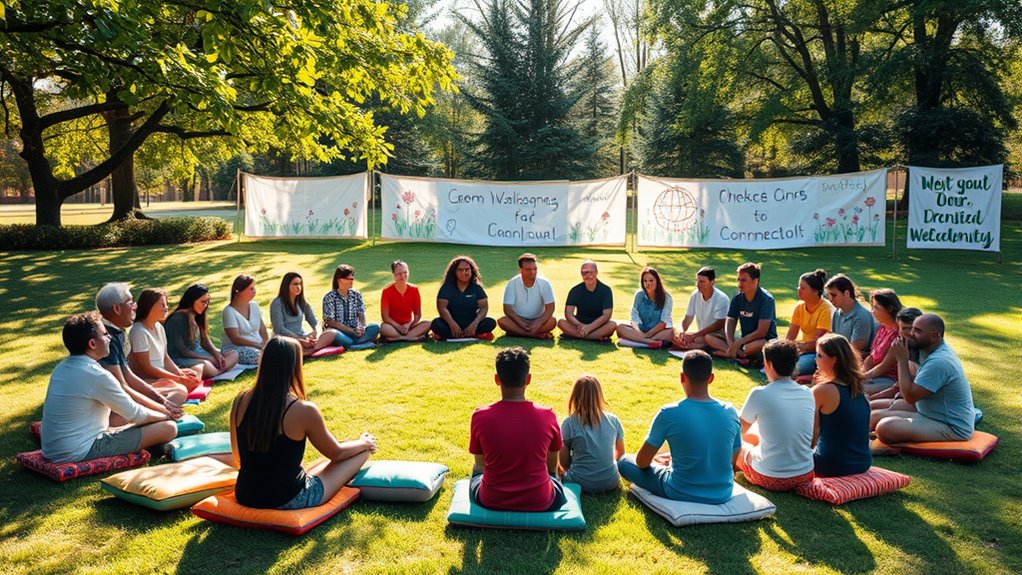
Creating a safe and inclusive environment is the foundation for meaningful participation in a community circle. Your role involves actively fostering trust building and demonstrating cultural awareness.
- Set clear expectations that promote respect and openness for all backgrounds.
- Encourage sharing by affirming diverse perspectives and experiences.
- Be mindful of cultural differences, adapting your approach to honor various communication styles.
- Model vulnerability and transparency to build trust, showing that everyone’s voice matters.
- Be aware of cookie categories and privacy considerations to ensure a respectful and secure space for all participants.
- Understanding the importance of well-being tips can help create a nurturing environment where participants feel supported and valued.
- Familiarizing yourself with PlayStation Support Hours and other entertainment park schedules can help you plan community activities during optimal times, ensuring inclusivity and convenience for all members.
- Incorporating insights from existential themes can deepen discussions and foster a more profound understanding of personal and collective purpose within the group.
Guiding the Conversation Effectively
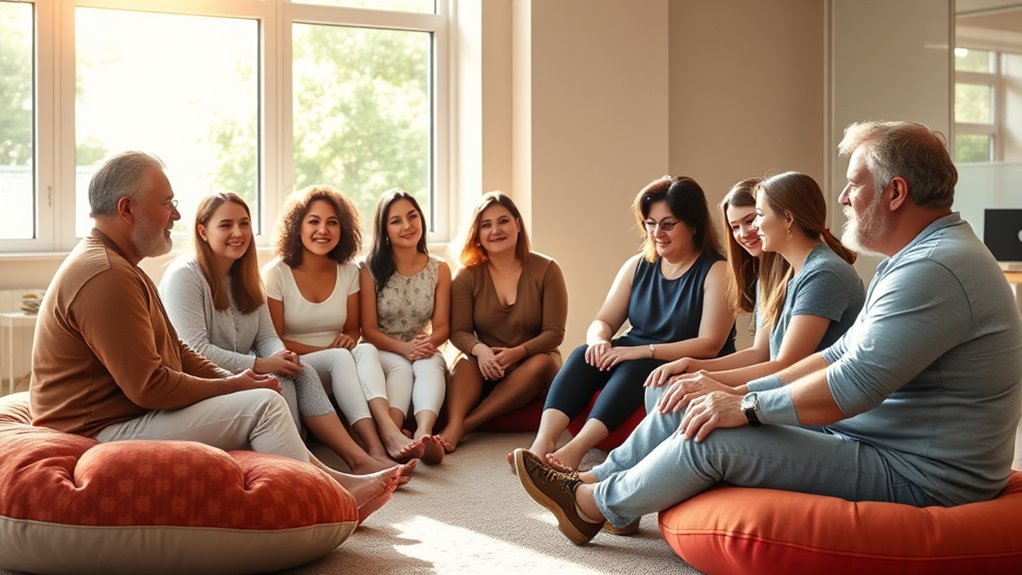
How can you guarantee that a community circle stays focused and productive? By guiding the conversation with clear, gentle prompts and actively practicing listening skills. Use emotional validation to acknowledge participants’ feelings, creating trust and openness. Stay on topic by gently steering discussions back when they drift, and encourage respectful listening. Establish a flow that balances sharing and reflection. Here’s a simple visual to help:
| Technique | Purpose |
|---|---|
| Use open-ended questions | Foster deeper sharing |
| Reflect feelings | Show understanding |
| Summarize key points | Clarify and keep focus |
| Validate emotions | Build trust and connection |
| Redirect when needed | Maintain productive flow |
Additionally, incorporating aquatic exercise can promote relaxation and improve overall well-being within the community, fostering a supportive environment. Practicing mindfulness during discussions can further enhance participants’ ability to stay present and engaged.
Encouraging Equal Participation
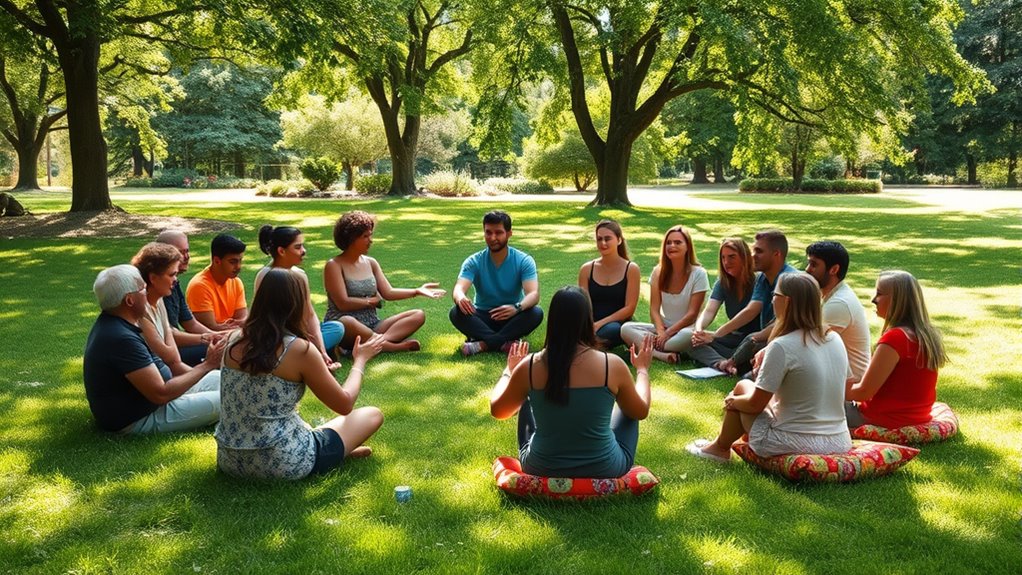
Have you noticed some voices dominate your community circle while others stay quiet? To encourage equal participation, you can create a safe space where everyone feels comfortable sharing personal stories. Use active listening to show genuine interest, which invites others to contribute. Consider these strategies:
- Set clear guidelines emphasizing respect and equal airtime.
- Invite quieter members to share by asking open-ended questions.
- Model sharing personal stories to build trust and openness.
- Gently redirect dominant voices to ensure balanced participation.
- Be mindful of co-parenting dynamics to foster a harmonious environment that supports everyone’s contributions. Additionally, understanding the importance of community support can enhance group cohesion and encourage more active involvement from all members. Incorporating segmentation techniques to tailor group discussions can also improve engagement and ensure diverse voices are heard. Recognizing that emotional support plays a vital role in group settings can help create an atmosphere where members feel valued and understood.
Reflecting and Closing the Circle
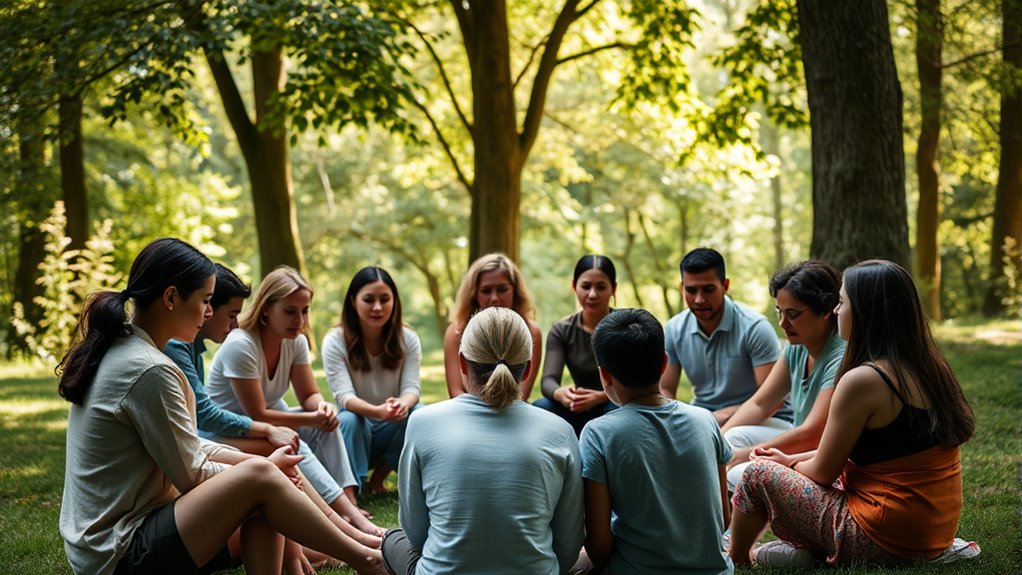
As your community circle comes to a close, taking a few moments to reflect helps everyone process their experience. Encourage participants to share personal stories or insights from the circle, which fosters connection and understanding. This sharing allows members to express what resonated most with them, deepening the sense of mutual support. Incorporating reflection techniques can enhance the emotional processing of the group. For example, guided questions or mindfulness exercises can help participants access their feelings more fully. You might also consider visualization methods to help participants envision their growth and connections. Afterward, invite everyone to express gratitude—for both the shared stories and the courage it took to participate. This act of appreciation leaves participants feeling valued and seen. Including positive reinforcement can further boost confidence and openness within the group. As you wrap up, offer a moment of silence or a closing statement that highlights the group’s collective strength. This reflection and gratitude help solidify the bonds formed during the circle, leaving everyone with a sense of closure and readiness for future gatherings.
Frequently Asked Questions
How Do I Handle Dominant Participants in the Circle?
When dealing with dominant participants, you need to focus on balancing participation and setting boundaries. Gently acknowledge their contributions, then invite others to share by saying something like, “Let’s hear from someone who hasn’t spoken yet.” If needed, set clear boundaries by reminding everyone of the circle’s purpose and time limits. This approach fosters an inclusive environment and guarantees all voices are heard equally.
What if Someone Shares Something Personal I Disagree With?
When someone shares something you disagree with, you should respect boundaries and manage emotions calmly. Acknowledge their perspective without judgment, saying something like, “Thank you for sharing that.” If needed, gently redirect the conversation to maintain a safe space for everyone. Remember, mutual support relies on respecting differences, even when you don’t see eye to eye. Your calm and respectful response fosters trust and understanding in the circle.
How Can I Manage Conflicts or Disagreements During the Session?
Imagine a gentle river flowing, even when rocks cause ripples. During disagreements, you can manage conflicts by practicing active listening, showing genuine emotional validation to each person’s feelings. When tensions rise, calmly acknowledge differing perspectives, encouraging respectful dialogue. Your role is to create a safe space where everyone feels heard, fostering understanding. By staying composed and empathetic, you help the group navigate conflicts smoothly, keeping the circle supportive and constructive.
What Are Quick Strategies to Re-Engage Distracted Participants?
When participants get distracted, you can quickly re-engage them with mindful listening by gently pausing and inviting their thoughts. Incorporate engaging activities like quick sharing rounds or movement breaks to revitalize focus. Use eye contact and expressive gestures to draw attention back to the group. These strategies keep the energy up, foster connection, and make sure everyone feels involved, creating a supportive environment for meaningful participation.
How Do I Adapt Circles for Virtual or Hybrid Formats?
When adapting circles for virtual or hybrid formats, you should focus on creating an engaging virtual adaptation. Use video conferencing tools that allow everyone to see and hear each other clearly. Incorporate breakout rooms for smaller conversations, and encourage participants to turn on cameras. For hybrid formats, make certain both in-person and remote attendees feel included by managing technology carefully and facilitating equal participation. This way, your community circle remains meaningful and connected.
Conclusion
When you facilitate a community circle, remember you’re weaving a tapestry of voices, each thread essential to the whole. By setting clear intentions, creating safety, guiding with care, and encouraging everyone to share, you foster trust and connection. As the circle closes, hold space for reflection, knowing that together, you’ve cultivated a garden of mutual support. Your nurturing hands help blossom understanding and resilience, turning a simple gathering into a powerful source of collective strength.
